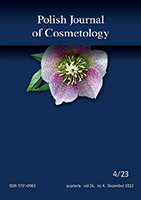search by
Copyright @ Pol J CosmetolAlkaline soaps. Part I. Effect of prescription composition on physicochemical properties determining the direction of applicationMarian M. Zgoda 1/, Aleksandra Janik 1/, Katarzyna Bujnicka 1/, Sławomira Nowak 2/, Zbigniew Marczyński 3/ 1/ Wyższa Szkoła Kosmetyki i Nauk o Zdrowiu w Łodzi 2/ Katedra i Zakład Farmakognozji Uniwersytet Medyczny w Łodzi 3/ Zakład Farmacji Aptecznej Katedra Farmacji Stosowanej Uniwersytet Medyczny w Łodzi Summary Introduction. In the prescription of high-quality population soaps, apart from sodium salts of higher fatty acids, which are the basis of surface-active compounds, there are also excipients that determine their application (hygiene) profile. The presence of essential oils, vitamins and provitamins as well as triglycerides, sodium chloride, EDTA sodium salts and above all water affects the effective duration of use. It also determines the mechanism of interaction on the hydrophilic-lipophilic balance on the surface of the skin. Aim. Conducting physicochemical tests in the pharmacopoeial standard of aqueous solutions of high-quality population soaps and marking in accordance with the Polish Standard acronym used in Poland (PN) water content and kinetics of loss of volatile components from the morphological structure of market products will allow a reliable estimation of their quality and hygiene profile. Material and methods. Selected high-quality population soaps: "Labell", "Luksja" and "Palmolive Naturals" were tested. The drying method recommended by the Polish Standard with a kinetic gravimetric measurement was used to estimate the water content and the rate of the loss of volatile components. The hydrogen ion activity - was measured in the solution and on the saponified soap surface by potentiometric method using selective electrodes. Electric conductivity of soaps was also measured in the aqueous solution. Results. The hydrogen ion activity - of aqueous solutions of soaps and on saponified surface determined by selective electrodes indicates their highly alkaline nature of ≤9.55. In the morphological structure of high-quality population soaps, the water content is estimated to range 5.92-16.13%. Soap bases are characterized by high content of water 22.77-23.90%. The rate of volatile components loss is described by kinetic equations of 0 order and the constant of the process rate was determined for morphological soap structures. Measured numerical values of electrical conductivity indicate high electrophoretic mobility of sodium ion. Conclusions. High-quality population soaps, regardless of the application profile, are characterized by alkaline values and the amount of water in the product determines the effective time of use and dosing (from saponification surface) of medicinal agents, vitamins, essential oils and unique triglycerides (after their earlier emulsification). Key words: soaps, water content, loss of volatile components, pH(aH+) of soap solutions, electric conductivity |




